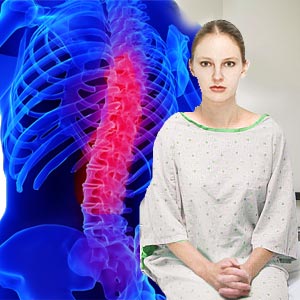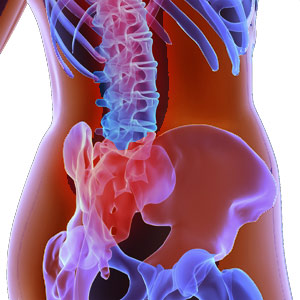Ankylosing Spondylitis

Inflammation of the vertebral joints is known as spondylitis. Spondylitis is also known as Spondyloarthritis or Spondyloarthropathy. Spondylitis can also be termed as inflammatory arthritis that largely affects the spine; there are instances when other joints and organs can also get affected.
Types of Spondylitis
Ankylosing spondylitis: Also known as sepondylitis deformans, ankylosing spondylitis
is the main type of spondylitis. This disease affects the spine making the spine rigid. Other joints that are usually affected include the vertebral column, sacroiliac joints, shoulders, and hip joints. The heels, shoulders, knees, hips, neck, and jaw also tend to become stiff. Ankylosing spondylitis occurs mainly in young adults and leads to severe pain, discomfort and soreness.
Cervical Spondylitis: Neck pain that affects the cervical spin is called cervical spondylitis. This pain can spread to the rear of the neck, both sides of the shoulder, collar bone and shoulder joints. It restricts neck movement and the arms become motionless due to weakness in muscles.
Lumbar Spondylitis: Pain in the lumbar region causes lumbar spondylitis.
Diseases grouped with spondylitis
This group of diseases primarily affects the spine (spondylo) and other joints.
Undifferentiated Spondyloarthropathy (USpA):People who can not be explicitly diagnosed for ankylosing spondylitis are classified under this category. Over a period of time they tend to develop definite symptoms as in ankylosing spondylitis cases.
Reactive Arthritis (ReA): Reactive Arthritis is also known as Reiter's Syndrome. This condition can cause inflammation and pain in the joints, skin, eye etc. Reactive arthritis happens as a reaction to an infection that might have started elsewhere in the body e.g. infection of the genitourinary or gastrointestinal tract.
Enteropathic arthritis: Enteropathic arthritis is a form of chronic, inflammatory arthritis. It is linked to inflammatory bowel disease (IBD) like ulcerative colitis and Crohn's disease. Areas usually affected by enteropathic arthritis are the peripheral limb joints.
Juvenile spondyloarthropathy (JSpA): Juvenile-onset spondyloarthritis (JSpA) or Juvenile spondyloarthropathy is a childhood rheumatic disease. Such type of arthritis occurs before the age of 16 and can extend into adult life. JSpA leads to pain and inflammation of joints in the lower part of the body. E.g. knees, ankles, hips and pelvis.
Psoriatic arthritis (PsA): 5-10% of patients with psoriasis develop arthritis too. Psoriasis comes first and after a few years arthritis shows up. Arthritis symptoms showing up with psoriasis is called as psoriatic arthritis (PsA).
Spondylitis symptoms
- Inflammation of the spine and other joints
- Back pain
- Hip pain
- Leg pain
- Spinal deformity
- Bowel incontinence
- Bladder incontinence
- Pain while moving the affected joint
- Decreased mobility
- Pins and needles or burning/tingling/creeping sensation of the skin in the back, leg and thigh
Spondylitis treatment
A common treatment regimen for the entire group of spondylitis (ankylosing spondylitis, reactive arthritis,
psoriatic arthritis, enteropathic arthritis and undifferentiated spondyloarthropathy) include:
Medication: NSAIDs (non-steroidal anti-inflammatory drugs) are prescribed to relieve the pain and stiffness associated with spondylitis. NSAIDs can cause side effects and may even damage the gastrointestinal tract. Patients not responding to NSAIDs can be treated with DMARDS i.e. rheumatic drugs like Methotrexate, Corticosteroids, etc. TNF blockers are also used to treat spondylitis these days.
Exercise: Exercise forms the primary part of spondylitis management program. Regular daily exercises can improve posture and flexibility and can also aid pain management. Exercise should be done under the guidance of a properly trained physical therapist.
Physical therapy: Physical therapy can help in relieving pain to great extent.
Good posture: Good posture helps in prevention of complications like stiffness and many more caused by spondylitis.
Heat/cold: Applying heat to stiff joints and tight muscles can bring down pain and soreness. Applying cold to inflamed areas can bring down swelling. Hot baths and showers also offer relief. Applying heat/cold can relax the muscles and lessen the joint pain.
Surgery: In severe/acute cases surgery is suggested.
Other options: Alternative treatments like massage and TENS (Transcutaneous Electrical Nerve Stimulation) unit (electrical stimulators for pain) can also relieve pain.
Maintaining desired body weight and balanced diet can also help in pain management.
Ankylosing Spondylitis
Ankylosing spondylitis is a form of arthritis that mainly affects the spine. It is also known as rheumatoid
ankylosis and is a chronic condition. There are chances that other joints of the body may also get affected. The inflammation of the spinal joints can cause severe pain and discomfort. In a few acute cases this inflammation can lead to the formation of a new bone on the spine. This condition will fuse the spine in a fixed position thus making it immobile and stooping it forward.
Ankylosing spondylitis can also cause inflammation, pain and/or stiffness in the small joints of the hands and feet, shoulders, hips, ribs and heels. This disease affects men more than it affects women.
Ankylosing spondylitis symptoms
Ankylosing spondylitis is a chronic form of arthritis. The main symptoms include:
- Back pain
- Stiffness of the back
- Limited flexibility
- Tenderness of the bones
Pain caused due to this condition may develop
- Gradually over months
- Increase with heavy activity
- Pain on both the sides
- Aggravate in the mornings
In 30% of the cases this condition progresses to affect the movement of the back as bones of the spine fuse together. Joint stiffness or limited range of motion in a few joints is called ankylosis. This condition may affect certain day-to-day activities. As days progress, ankylosing spondylitis might affect the joints between the spine and ribs.
Symptoms at advanced stages
Ankylosing spondylitis affects the eyes in up to 40%of cases. Inflammation of the eye caused by this condition
is called acute iritis. This symptom can lead to:
- Eye pain
- Redness
- Watering of the eyes
- Blurred vision
- Increased sensitivity to light
- Weight loss
- Bowel inflammation
- Loss of appetite
- Difficulty in expanding the chest
A person suffering from ankylosing spondylitis might experience fever, muscle aches or pain, excessive tiredness, a decrease in red blood cells (anemia) and weight loss. These symptoms are more common in children than in adults.
Ankylosing Spondylitis Treatment
Physical therapy
- Pain-relief methods
- How to protect joints
- How to conserve energy
- Proper body mechanics
Exercise: Exercise is intrinsic to spondylitis management program. Regular daily exercises can improve posture and flexibility and can also be helpful in pain management. Exercise should be done under the guidance of a properly trained physical therapist.
Psoriatic spondylitis Psoriatic arthritis is a type of arthritis linked with spondylitis. This disease is a condition associated with psoriasis and chronic joint symptoms. Usually the symptoms of psoriasis and joint inflammation show up separately.
In 85%of patients, symptoms of psoriasis develop before arthritis. In 15% of the patients arthritis develops before psoriasis. Symptoms for psoriatic arthritis vary depending on the joint affected and the pattern of its occurrence. Common symptoms associated with psoriatic arthritis include:
- Conjunctivitis
- Morning stiffness of joints
- Fatigue
- Swollen fingers and toes
- Tendinitis
- Low back pain
There is no single test that can determine psoriatic arthritis. Physical examination, x-rays, blood tests and MRI are used to determine the right type of arthritis.
Types of psoriatic arthritis
Arthritis mutilans: Arthritis mutilans is a severe type of psoriatic arthritis that can disable a person. Less than 5%of people with psoriatic arthritis are affected by this type of arthritis. Joint deformity is
the main symptom, the small joints of the hands and feet being the most affected. Neck pain and low back pain are also common.
Symmetric: Symmetric psoriatic arthritis affects joints on both sides of the body, e.g. both sides of the hips, both knees etc. This type of arthritis usually affects multiple joints. It is just like rheumatoid arthritis but is milder and has less deformity. 25% of people suffering from psoriatic arthritis belong to this category.
Asymmetric: Asymmetric psoriatic arthritis does not affect the same joint on both the sides of the body. It affects any joint in the body. Joints become red, warm, swollen and painful. This is a mild form of psoriatic arthritis. About 80% of psoriatic arthritis patients are affected by this type.
Distal Interphalangeal Predominant: Distal Interphalangeal Predominant (DIP) psoriatic arthritis occurs in about 5 - 10 % of psoriatic arthritis patients. The main joints to be affected include the distal joints of the fingers and toes.
Spondylitis: Spondylitis is a type of psoriatic arthritis wherein the spine is inflamed. About 5 to 20%of psoriatic arthritis patients are affected with this type of spondylitis.
Top of the Page: Ankylosing Spondylitis
Tags:#spondylitis #ankylosing spondylitis #
 Slipped Disc
Slipped Disc Knee Replacement for Women
Rheumatoid Arthritis
Osteoarthritis
Drop Wrist Deformity
Ankylosing Spondylitis
Spinal Decompression
Scoliosis Treatment
Cause of Osteoporosis
Osteopenia
Bone Density Test
Disc Herniation
Tennis Elbow Symptoms
Restless Leg Syndrome Symptoms
Other health topics in TargetWoman Women Health section:
General Women Health

Women Health Tips - Women Health - key to understanding your health ...
Cardiac Care
Women's Heart Attack Symptoms - Identify heart problems...
Skin Diseases
Stress Hives - Red itchy spots ...
Women Disorders
Endocrine Disorder - Play a key role in overall wellbeing ...
Women's Reproductive Health
Testosterone Cream for Women - Hormone replacement option ...
Pregnancy
Pregnancy - Regulate your lifestyle to accommodate the needs of pregnancy ...
Head and Face
Sinus Infection - Nearly 1 of every 7 Americans suffer from ....
Women and Bone Care

Slipped Disc - Prevent injury, reduce pain ...
Menstrual Disorders
Enlarged Uterus - Uterus larger than normal size ...
Female Urinary Problems
Bladder Problems in Women - Treatable and curable ...
Gastrointestinal Disorders
Causes of Stomach Ulcers - Burning feeling in the gut ...
Respiratory Disorders
Lung function Test - How well do you breathe ...
Sleep Management

Insomnia and Weight Gain - Sleep it off ...
Psychological Disorders in Women
Mood swings and women - Not going crazy ...
Supplements for Women
Women's Vitamins - Wellness needs...
Natural Remedies

Natural Diuretic - Flush out toxins ...
Alternative Therapy
Acupuncture Point - Feel the pins and needles ...
Women Health Directory
Top of the Page: Ankylosing Spondylitis
Popularity Index: 100,639

